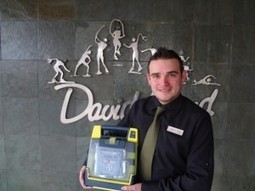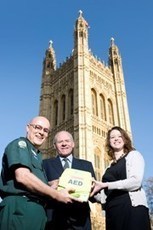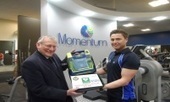See on Scoop.it – Defibrillation

David Lloyd Leisure’s health clubs do business throughout Europe; the company has 80 sites in the UK alone. With more than 440,000 members the company gets 25 million club visits a year. Since 1998, the David Lloyd Leisure staff has used AEDs to save the lives of more than 100 people.
There’s no legal requirement in the UK for fitness clubs to have automated external defibrillators (AEDs) on the premises. But the health and safety experts at David Lloyd Leisure insist on having AEDs readily accessible at every one of their busy clubs. This policy, along with staff training in AED use, has made a world of difference. Since 1999, David Lloyd Leisure has saved more than 100 lives.
“Our feeling is every fitness facility should have an AED, even if there’s no legal requirement,” says Caleb Brown, of the health and safety office at David Lloyd Leisure. “AEDs have become so affordable, and the response element is something which is really easy for a health club to do — they’ve already got team members available.”
One of Europe’s largest health and fitness businesses, David Lloyd Leisure started its AED program in 1998. At first, this simply meant ensuring that the reception desk at every facility had a defibrillator at hand.
A staff member from David Lloyd Leisure Brooklands with their Powerheart AED. Staff at the club used the AED to revive a member in 2010.
The return on investment in terms of lives saved was immediate, and the company nurtured the AED program. Brown, who joined the company in 2000, has been involved in the development of the company’s AED training program as part of overall safety training. Today, an AED is brought immediately to the scene of any health incident at one of the clubs.
While the survival rate for people who suffer outside-of-hospital sudden cardiac arrest in the United Kingdom is less than 20 percent, the survival rate for someone who suffers cardiac arrest or another serious health incident at one of the David Lloyd Leisure clubs reached 88 percent in 2012.
How They Chose Powerheart AEDs
All David Lloyd Leisure clubs are equipped with at least one AED, and one large, six-story site has two defibrillators on the premises. All the AEDs — with the exception of devices at clubs recently acquired from other companies — are Cardiac Science Powerheart AED G3s. The Powerheart AEDs were chosen because they’re highly portable and easy to use, with long-lasting medical-grade batteries and Rescue-Ready technology that conducts an automatic self-check of the main components (battery, hardware, software, and pads) every day. When it’s nearing time to replace a battery, a Rescue Ready indicator on the AED turns red and sounds an alert.
“The Powerhearts are so easy to look after, and the maintenance system is brilliant,” Brown says.
In the aftermath of any incident in which an AED was required, the club replaces the used pads with a set of spares. Brown, or one of his health and safety team colleagues, then visits the club to download data from the AED for hospital use, write up an incident report, and supply a new set of spare pads.
Training: Key to a Successful AED Program
Brown, who took on a leadership role in the AED program in 2006, has designed training for club employees that enables them to respond with maximum speed and efficiency when a cardiac incident occurs.
“Because of the voice prompts, even an untrained bystander can use an AED,” Brown points out. “With a training program, you give people the ability to react faster in an event, which is going to increase chances of survival.”
Ambulance response time in urban areas in the UK is usually under 8 minutes, Brown noted, but for a sudden cardiac arrest victim that is often too late. Brown’s goal has been to train David Lloyd Leisure staff to get the AED to the victim, and the defibrillator pads on the victim’s chest, within 1 minute.
Once the pads are attached, the AED can diagnose the heart rhythm, and, if appropriate, administer a shock. The AED’s voice prompts coach the team through every step of the process, including administering CPR. The AEDs are programmed in accordance with the latest resuscitation guidelines, and David Lloyd Leisure bases its training on those same guidelines.
“I believe that some businesses overestimate the amount of training that is required for a successful AED program,” Brown says. “Our training is only two hours for an employee, once a year. With just that basic training, in the vast majority of incidents requiring an AED, we are able to get the pads onto the chest in less than a minute.”
In 2012, the company’s survival rate for incidents in which an AED was deployed reached 88 percent.
Case Study: Saving a Life at the Health Club
“I would not be alive now had it not been for the quick intervention of Paul, Laura,and others and their ability to resuscitate me,” a 45-year-old businessman wrote in a letter to David Lloyd Leisure. “I have been advised by doctors that if I had been anywhere else, in particularly where there was no defibrillator, I would not have survived.”
The man had collapsed while using a rowing machine at the North London club. Bystanders alerted the club’s team straightaway, and one of the team immediately started CPR. The AED was brought to the area and the pads put on immediately. The AED diagnosed a shockable heart rhythm and it administered one shock.
“By the time the ambulance crew arrived, the man was breathing and talking,” Caleb Brown, part of the company’s health and safety team, said. “He went on to make a complete recovery, went back to work, and he’s back at the club.”
Two members of the David Lloyd Leisure staff were directly involved in the rescue. One delivered CPR and the other used the AED. A half dozen others assisted, clearing members from the area and making sure there was access for the ambulance crew.
“The training I received in using the AED enabled me to use the AED with confidence and the clear voice prompts helped to keep me calm,” one of the rescuers reported after the incident. “It’s an amazing feeling to know that the actions I took resulted in a life being saved.”
See on www.cardiacscience.com


 Follow
Follow


